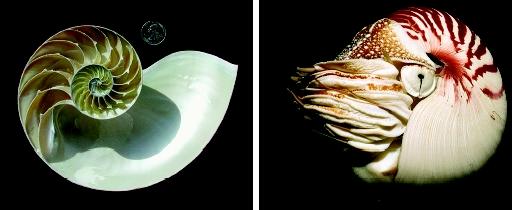Cephalopods
What group of marine invertebrates was celebrated by a Chief Justice of the Supreme Court of the United States? (Answer: cephalopods.) Oliver Wendell Holmes (1809–1894) wrote the poem "The Chambered Nautilus" in 1858 to describe the shell of the cephalopod Nautilus.
Nautilus belongs to the cephalopods, a category of mollusks to which the octopus, squid, and cuttlefish octopus also belong. The phylum Mollusca also includes the gastropods (snails and slugs) and bivalves (such as clams and oysters) among others, and is considered one of the most intelligent and successful invertebrate groups in the oceans.
Major Characteristics
All cephalopods live in the marine environment, where they are carnivores. A shared trait of the group are sucker-bearing tentacles used to seize and hold prey. The tentacles range in number from eight in the octopus to more than ninety in Nautilus. The tentacles surround a powerful beak-like mouth.
Many living cephalopods (but not Nautilus ) possess an ink sac capable of ejecting a dark fluid to confound predators. Some octopuses, squids, and

While most other mollusks have hard external shells, most cephalopods do not. Nautilus has a planispherally coiled external shell, while squids and cuttlefish have a smaller internal skeleton, and octopus has no hard skeleton at all. The cephalopods all have two well-developed eyes used in hunting prey. The octopus spends most of its time scurrying along the seafloor, feeding on other bottom dwellers such as crabs. In contrast, Nautilus and squids are active swimmers and also can prey on fish. All cephalopods can move backwards fairly quickly by expelling water in a type of jet propulsion.
Because they are elusive creatures, the habits and ecological details of most species of cephalopods are unknown. Similarly, the population sizes are not well known, making it difficult in many cases to determine if a species is endangered. Overfishing of the most commercially desirable species has occurred in the past. Because of the rapid reproduction of cephalopods, a temporary ban on fishing often is successful in restoring the fishery populations.
Octopuses, Cuttlefish, and Squid
There are approximately two hundred species of octopuses, found throughout the world primarily in shallow coastal waters. The most common species, Octopus vulgaris, is approximately 1 meter (3 feet) at adulthood, and lives for up to 18 months. The solitary O. vulgaris lives inside a small cave or den on the ocean bottom, and will inhabit tires, barrels, and other hollow spaces in human debris, if available. This habit is exploited by humans who harvest octopuses by setting and retrieving "octopus pots" made of clay or plastic. O. vulgaris is the principal commercially harvested octopus.
Cuttlefish are found in the eastern Atlantic Ocean and the Mediterranean Sea. The common cuttlefish, Sepia officinalis, is about one-third of a meter long (about 1 foot) as an adult. Ink from the cuttlefish has been used for centuries for writing, and its hard internal shell, the cuttlebone, often is placed in birdcages for beak-sharpening and as a source of calcium.
Octopuses have eight arms, whereas squids have ten, two of which are longer and specialized for feeding. Squids are deemed not as intelligent as octopuses, but are more streamlined and much faster and stronger swimmers, chasing down their prey at top speeds of over 12 kilometers (20 miles) per hour. Squid are fed upon by birds, sea mammals such as sperm whales, and humans. The annual catch of squid is in the hundreds of thousands of metric tons, most of which is caught by Japanese fisherman.
Giant Squid.
Perhaps the most spectacular of the living cephalopods is the giant squid. The giant squid, Architeuthis (Greek for "ruling squid"), is present in the deep oceans around the world, but most commonly has been found near New Zealand. Living at depths of up to 1,000 meters (about 330 feet), Architeuthis probably feeds on fish and other smaller squids. The elusive animal has never been observed alive in its deep-sea habitat, but dead or dying specimens up to 19 meters (60 feet) long have been caught by fishermen, washed up on beaches, or become stranded in shallow waters. Some scientists think strandings may be increasing due to effects of global warming.

Although the giant squid is one of the largest predators in the ocean, it is considered a tasty meal by an even larger predator, the sperm whale. Remains of the horny beaks of giant squids have been found in the stomachs of sperm whales, and sucker marks from the tentacles of giant squids are found on whales.
Nautilus
Nautilus is found in the southwestern Pacific Ocean and Indian Ocean. It lives at a depth of several hundred meters during the day, but will come up as shallow as 5 meters (16 feet) during the night to hunt. Planispheral shells of the Nautilus can be cut into two halves that are bilaterally symmetrical. In contrast, conispheral shells (such as most snails) coil along a vertical axis forming a pointed spire, and are not symmetrical.
As the living Nautilus grows, it secretes a larger extension of the shell and seals off the older segments of the shell with thin, curved walls called septa. These concave-forward septa form the chambers of the Nautilus. A fleshy cord called the siphuncle connects the chambers. The empty chambers are filled with gas at about atmospheric pressure. The animal can regulate its buoyancy by slowly pumping fluids in and out of the empty chambers through the siphuncle.
The Nautilus ' shell is thin, only 1 or 2 millimeters (less than a tenth of an inch), but extremely strong. A strong shell is necessary to resist the great pressures experienced at the depth where Nautilus lives. Experiments with living Nautilus have shown that the shell can endure pressure at depths of up to 600 meters (200 feet) before the shell implodes.
SEE ALSO Bivalves .
David M. Rohr
Bibliography
Clarkson, Euan N. K. Invertebrate Palaeontology and Evolution . Cambridge, U.K.: Blackwell Science, 1998.
Voss, Gilbert L. "Squids: Jet-Powered Torpedoes of the Deep." National Geographic Magazine (March, 1967):386–411.
Ward, Peter D., Lewis Greenwald, and Francise Rougerie. "Shell Implosion Depth for Living Nautilus macromphalus and Shell Strength of Extinct Cephalopods." Lethaia 13 (1980):182.
Internet Resources
Search for the Giant Squid. Smithsonian Institution. <http://partners.si.edu/squid> .
Wood, James B. "The Cephalopod Page." Dalhousie University. http://www.dal.ca/~ceph/TCP/index.html> .